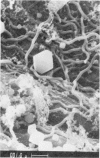Abstract
The various hypotheses concerning the etiologic agent of erythema chronicum migrans of Europe and of Lyme disease in the United States are reviewed, and an account of events that led to the discovery of the causative spirochetal agent in Ixodes dammini is presented. Spirochetes morphologically and antigenically similar, if not identical to, the organism detected in I. dammini were also found for the first time in Ixodes pacificus and Ixodes ricinus, the vectors hitherto incriminated, respectively, in western United States and Europe. In most infected ticks, spirochetal development was found to be limited to the midgut. Ticks with generalized infections were shown to transmit spirochetes via eggs, but infections decreased in intensity and became restricted to the central ganglion as filial ticks developed to adults. Although the mechanisms of transmission to a host are still under investigation, the spirochetes may be transmitted by saliva of ticks with generalized infectious and possibly also by regurgitation of infected gut contents, or even by means of infected fecal material.
Full text
PDF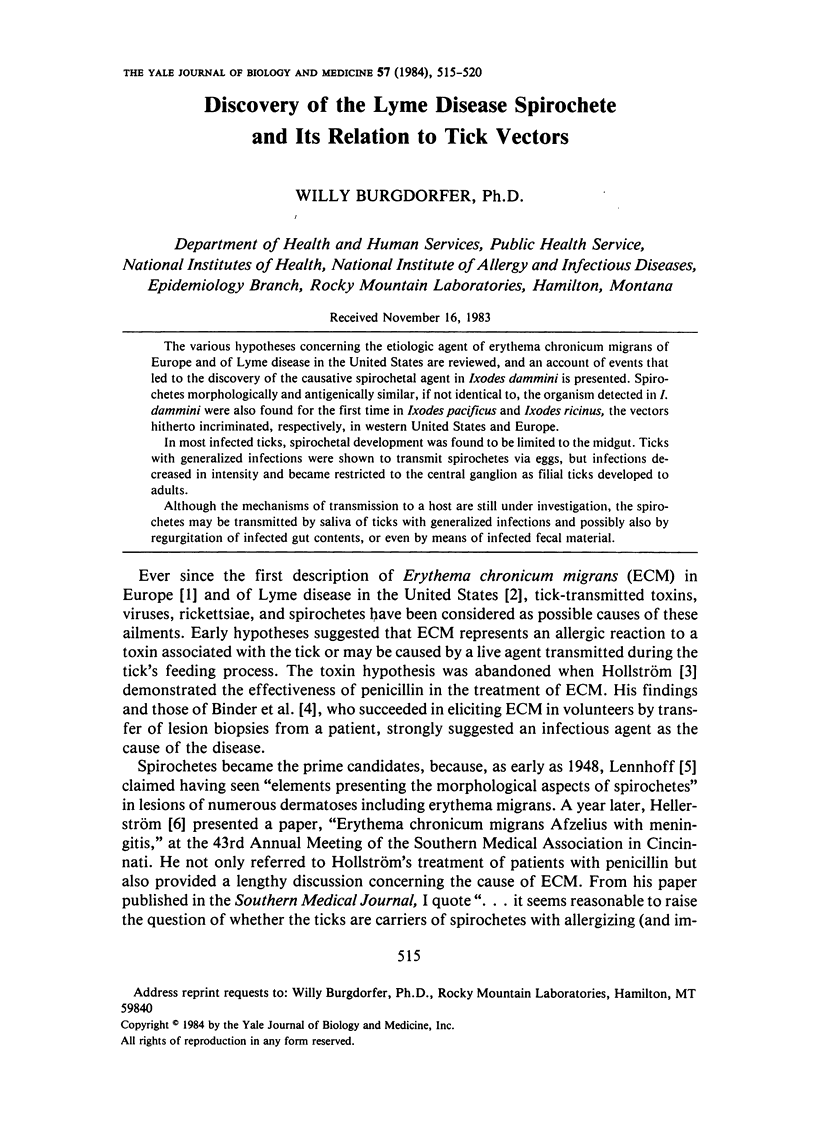
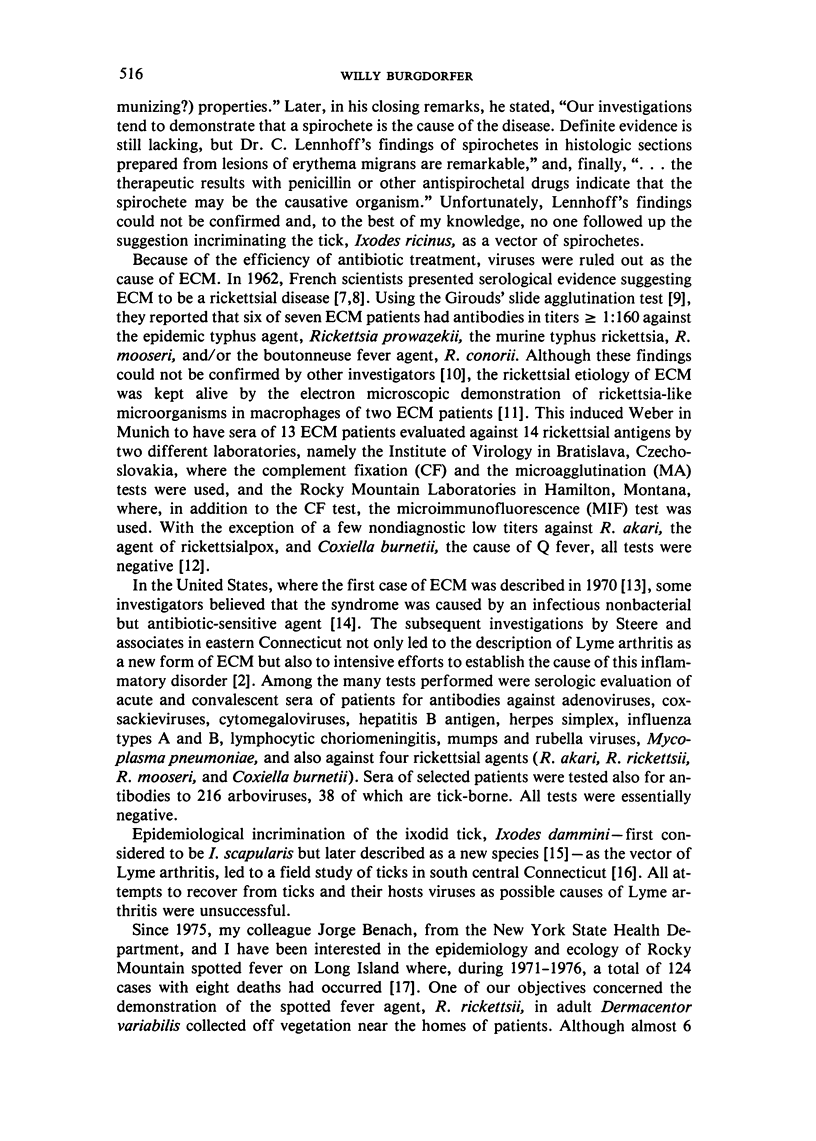
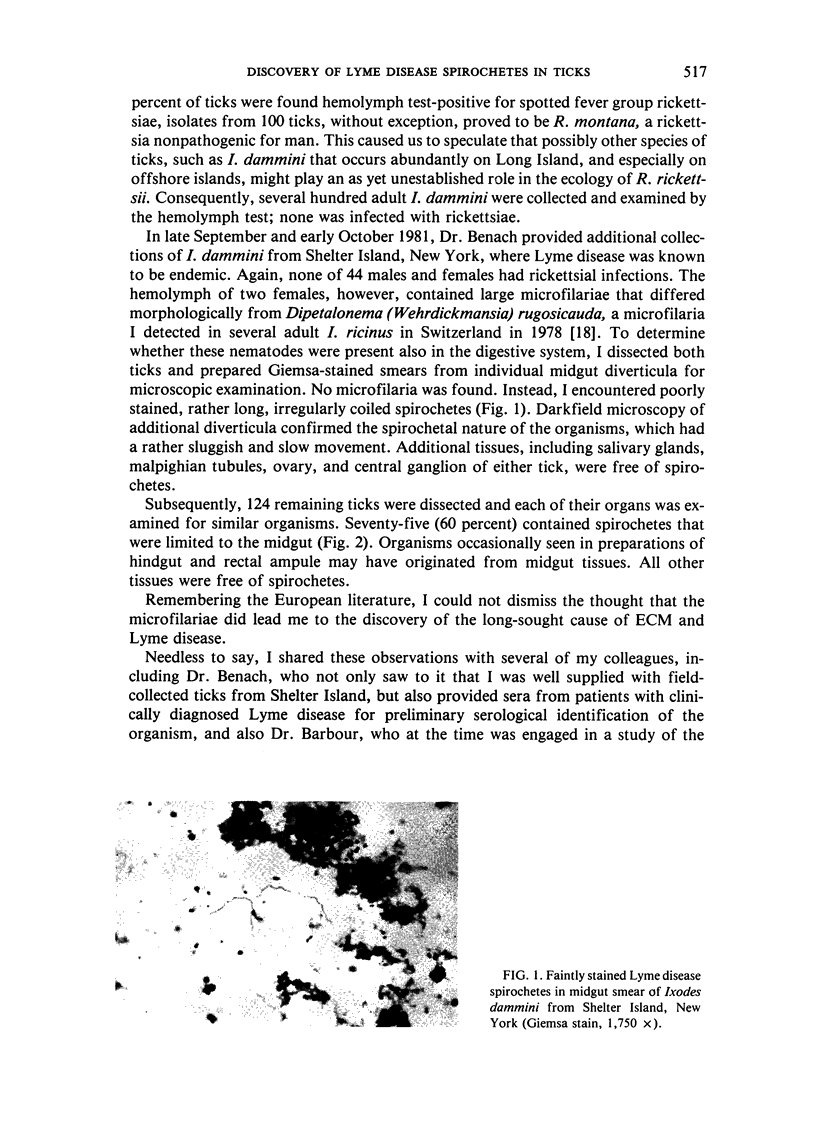
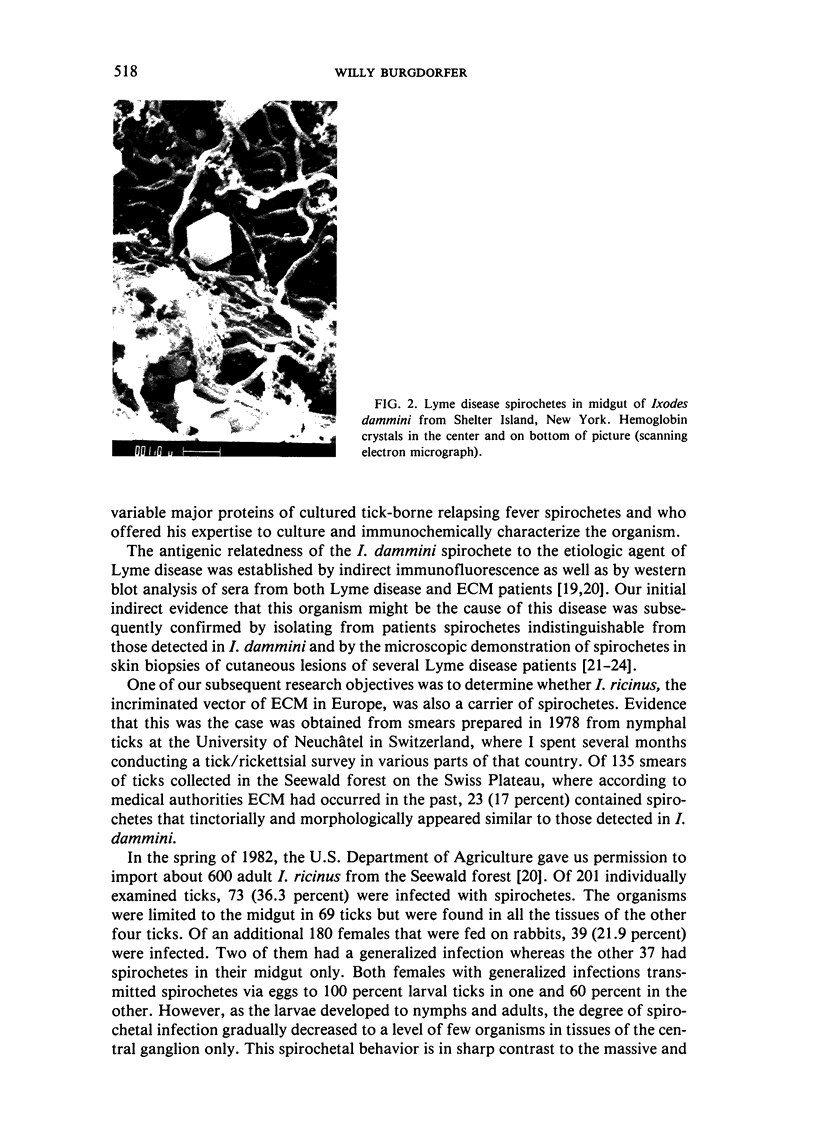
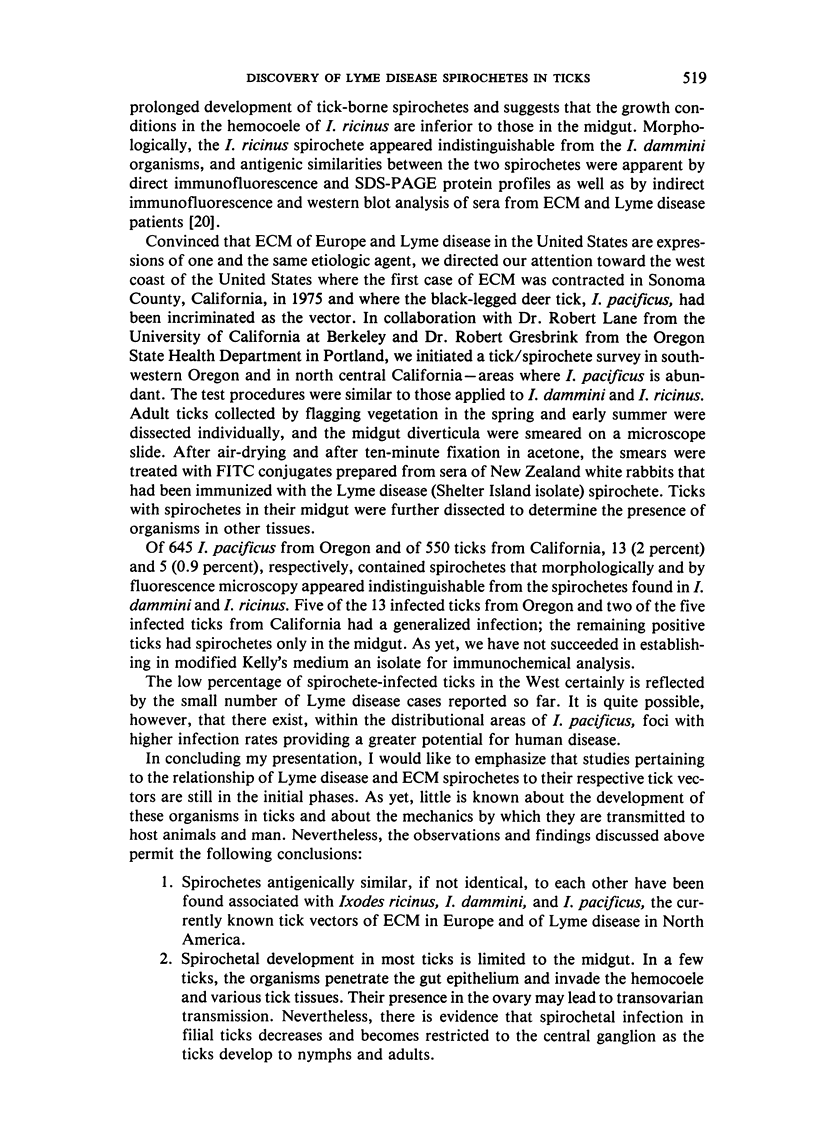
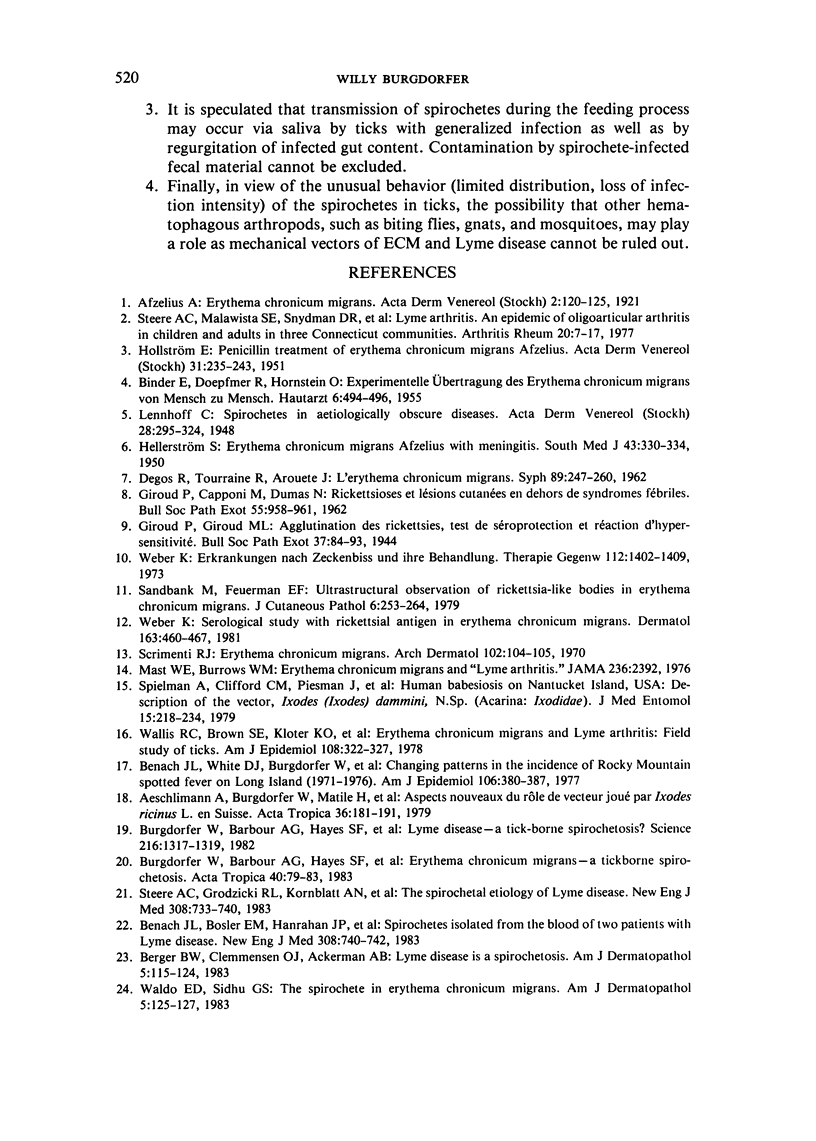
Images in this article
Selected References
These references are in PubMed. This may not be the complete list of references from this article.
- Aeschlimann A., Burgdorfer W., Matile H., Peter O., Wyler R. Aspects nouveaux du rôle de vecteur joué par Ixodes ricinus L. en Suisse. Note préliminaire. Acta Trop. 1979 Jun;36(2):181–191. [PubMed] [Google Scholar]
- BINDER E., DOEPFMER R., HORNSTEIN O. Experimentelle Ubertragung des Erythema chronicum migrans von Mensch zu Mensch. Hautarzt. 1955 Nov;6(11):494–496. [PubMed] [Google Scholar]
- Benach J. L., Bosler E. M., Hanrahan J. P., Coleman J. L., Habicht G. S., Bast T. F., Cameron D. J., Ziegler J. L., Barbour A. G., Burgdorfer W. Spirochetes isolated from the blood of two patients with Lyme disease. N Engl J Med. 1983 Mar 31;308(13):740–742. doi: 10.1056/NEJM198303313081302. [DOI] [PubMed] [Google Scholar]
- Benach J. L., White D. J., Burgdorfer W., Keelan T., Guirgis S., Altieri R. H. Changing patterns in the incidence of Rocky Mountain Spotted Fever on Long Island (1971-1976). Am J Epidemiol. 1977 Nov;106(5):380–387. doi: 10.1093/oxfordjournals.aje.a112479. [DOI] [PubMed] [Google Scholar]
- Berger B. W., Clemmensen O. J., Ackerman A. B. Lyme disease is a spirochetosis. A review of the disease and evidence for its cause. Am J Dermatopathol. 1983 Apr;5(2):111–124. [PubMed] [Google Scholar]
- Burgdorfer W., Barbour A. G., Hayes S. F., Benach J. L., Grunwaldt E., Davis J. P. Lyme disease-a tick-borne spirochetosis? Science. 1982 Jun 18;216(4552):1317–1319. doi: 10.1126/science.7043737. [DOI] [PubMed] [Google Scholar]
- Burgdorfer W., Barbour A. G., Hayes S. F., Péter O., Aeschlimann A. Erythema chronicum migrans--a tickborne spirochetosis. Acta Trop. 1983 Mar;40(1):79–83. [PubMed] [Google Scholar]
- DEGOS R., TOURAINE R., AROUETE J. [Chronic erythema migrans. (Discussion of a rickettsial origin)]. Ann Dermatol Syphiligr (Paris) 1962 May-Jun;89:247–260. [PubMed] [Google Scholar]
- HOLLSTROM E. Successful treatment of erythema migrans Afzelius. Acta Derm Venereol. 1951;31(2):235–243. [PubMed] [Google Scholar]
- LENNHOFF C. Spirochaetes in aetiologically obscure diseases. Acta Derm Venereol. 1948;28(3):295–324. [PubMed] [Google Scholar]
- Mast W. E., Burrows W. M. Erythema chronicum migrans and "lyme arthritis". JAMA. 1976 Nov 22;236(21):2392–2392. doi: 10.1001/jama.236.21.2392d. [DOI] [PubMed] [Google Scholar]
- Sandbank M., Feuerman E. J. Ultrastructural observation of rickettsia-like bodies in erythema cronicum migrans. J Cutan Pathol. 1979 Aug;6(4):253–264. doi: 10.1111/j.1600-0560.1979.tb01132.x. [DOI] [PubMed] [Google Scholar]
- Scrimenti R. J. Erythema chronicum migrans. Arch Dermatol. 1970 Jul;102(1):104–105. [PubMed] [Google Scholar]
- Spielman A., Clifford C. M., Piesman J., Corwin M. D. Human babesiosis on Nantucket Island, USA: description of the vector, Ixodes (Ixodes) dammini, n. sp. (Acarina: Ixodidae). J Med Entomol. 1979 Mar 23;15(3):218–234. doi: 10.1093/jmedent/15.3.218. [DOI] [PubMed] [Google Scholar]
- Steere A. C., Grodzicki R. L., Kornblatt A. N., Craft J. E., Barbour A. G., Burgdorfer W., Schmid G. P., Johnson E., Malawista S. E. The spirochetal etiology of Lyme disease. N Engl J Med. 1983 Mar 31;308(13):733–740. doi: 10.1056/NEJM198303313081301. [DOI] [PubMed] [Google Scholar]
- Steere A. C., Malawista S. E., Snydman D. R., Shope R. E., Andiman W. A., Ross M. R., Steele F. M. Lyme arthritis: an epidemic of oligoarticular arthritis in children and adults in three connecticut communities. Arthritis Rheum. 1977 Jan-Feb;20(1):7–17. doi: 10.1002/art.1780200102. [DOI] [PubMed] [Google Scholar]
- Waldo E. D., Sidhu G. S. The spirochete in erythema chronicum migrans. Demonstration by light and electron microscopy. Am J Dermatopathol. 1983 Apr;5(2):125–127. doi: 10.1097/00000372-198304000-00009. [DOI] [PubMed] [Google Scholar]
- Wallis R. C., Brown S. E., Kloter K. O., Main A. J., Jr Erythema chronicum migrans and lyme arthritis: field study of ticks. Am J Epidemiol. 1978 Oct;108(4):322–327. doi: 10.1093/oxfordjournals.aje.a112626. [DOI] [PubMed] [Google Scholar]
- Weber K. Erkrankungen nach Zecksnbibb und ihre Behandlung. Ther Ggw. 1973 Sep;112(9):1402–1409. [PubMed] [Google Scholar]
- Weber K. Serological study with rickettsial antigens in erythema chronicum migrans. Dermatologica. 1981;163(6):460–467. doi: 10.1159/000250216. [DOI] [PubMed] [Google Scholar]




